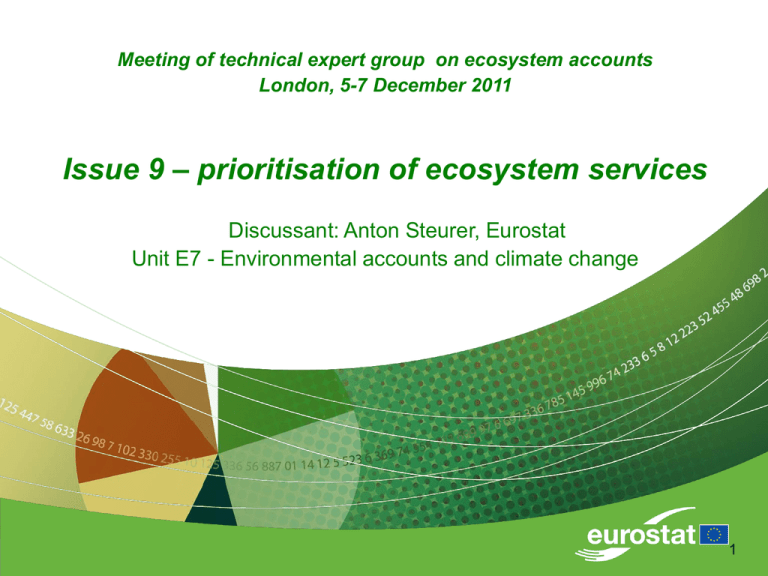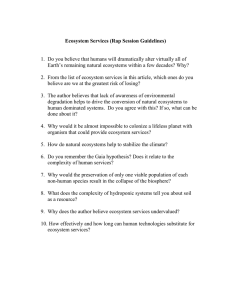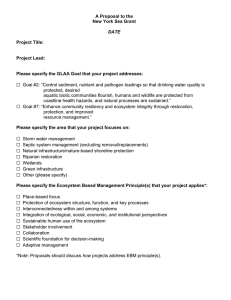– prioritisation of ecosystem services Issue 9 Discussant: Anton Steurer, Eurostat
advertisement

Meeting of technical expert group on ecosystem accounts London, 5-7 December 2011 Issue 9 – prioritisation of ecosystem services Discussant: Anton Steurer, Eurostat Unit E7 - Environmental accounts and climate change 1 Overview of presentation Issue 9 task – Prioritise ecosystem services (prioritise accounts of ecosystems?) Issues with a direct effect on the task (=What) – Clarify: Classification and coverage; Definition of ecosystem; Definition of ecosystem services vs SNA goods and services; relations among services (‘intermediate’ and ‘final’, competitive services, etc.) Criteria for prioritisation and their ranking (=How) – Importance/scale; criticality/risk; endangeredness; do-ability (data, methods), policy relevance/user needs Assessment (=apply the criteria to the objects) 2 Papers 4 papers – Simone Maynard+Stephen Cork (‘qualitative’ - underlines current lack of harmonisation of prioritisation approaches – also lack of harmonised underlying lists/classifications) – Lars Hein (‘scientific’ - based on survey - doability focus, ‘full’ scoring) – Roy Haynes-Young (‘policy-driven’ - prioritisation should be driven by needs, risk and restoration costs rather than data) – Hauser et al (discovered on the agenda – indicator lists and how they fit to accounts – reminds us of physical vs monetary priority) Objectives of papers of Lars vs Roy: potential for inclusion in accounting vs utility to or demand from decision makers 3 Task Task as defined in the List of Issues: – Review criteria for prioritising ecosystem services measurement – Analyse interrelations among (ecosystem) services – Determine relevance and feasibility (of compilation) – Investigate data availability at different levels, and physical and monetary Prioritise what – (size of) ecosystem services to be measured (=‘output’ of ecosystem), or (state of) ecosystems (= ‘asset’), or change in one of these? (It seems we agree that the service determines the scale and boundary of the ecosystems we look at. Matrices showing services by ecosystem) Prioritisation for what – For SEEA part 2 (i.e. indicating experimental accounts areas, research agenda) or for national applications (i.e. rules for applying a framework to circumstances) or for any assessment (not just accounts) Preconditions: we agree on working definitions of terms, a list of ecosystem services, on ‘A’ or ‘B’ or joint production – do we do goods? 4 Issues with direct impact on the task Services only or also goods? (e.g. the ‘service’ is biomass or water, or is it the potential to withdraw biomass or water) What do we want to cover (ecosystem vs environment) – has an impact on the list of ecosystem services – Ecosystem = functional unit of living and non-living things or can it be entirely non-living, i.e. must there be interaction between the two so if the living part collapses then the ecosystem service stops? – Examples where that is not the case: solar, thermal, wind or tidal energy. Land as pure space. Salt or sand for construction. Quantitative water cycling (and e.g. use as cooling water). Decomposition of pollutants by chemical reactions/sunlight in air. Classification – Groups in CICES agreed (provisioning, regulation, cultural)? – Detailed classes, groups and types agreed? 5 Issue with direct impact on the task Agreement on links among services achieved? – ‘Competition’: carbon sequestration versus material extraction/biofuels (can we count both?), provisioning and depollution services (services captured via the quality of other goods or services – water, food), etc. – Economic recording (valuation) – which services are already captured in national accounts (e.g. in tourism), captured but at a price of zero (e.g. pollination), captured but only in asset values - not in output and value added (amenities in land or enterprise value - dehezas), not captured (biodiversity protection outside touristic areas) Intermediate (or supportive) vs final services: term is used in different ways. – Ecosystems use intermediate ecosystem services to produce final ecosystem services (‘intra-ecosystems’ use) – Intermediate services used by economic production but do not become final product (e.g. soil fertility, pollination) – Intermediate services = supporting service = regulating services? – Intermediate services better measure asset status (‘ecosystem health’) – Is it accepted to look only at final services to avoid double counting? 6 Criteria for prioritisation Economic importance – Economic size; large scale; direct benefits Criticality/being ‘essential’ for wellbeing (for society) Endangeredness/vulnerability/irreversibility (risk) – can be low economic size, but have significant restoration costs Feasibility of compilation - physical and monetary – We have or can get data and accepted methods (sustainable data)? Manageability (can the measured feature be (politically) influenced) Policy/user needs ‘Ecosystem link or scale’ (importance of large scale functioning ecosystems for the service at stake) Nagoya: restore ‘essential’ services, UK NEA (are there ‘external’ lists?) 7 Assessment – (mis)interpreting the results of Hein Service (excludes provisioning!) Economic importance Data and methods Manageability, risk Strength of ecosystem link (or scale)(?) Score Carbon sequestration +++ +++ +++ ++ +++ Recreation and tourism +++ +++ ++ ++ +++ Air quality ++ +++ ++ 0 ++ Flood protection ++ ++ +++ + ++ Amenity service (living envt) ++ + ++ + ++ Hydrological flow regulation ++ + ++ + + Erosion control + + ++ + + Soil fertility ++ ++ ++ 0 + Pollination ++ ++ + + + Pest control + + + + + Nursery service + ++ + + + Inspiration 0 0 0 + 0 8 Questions for discussion Prioritising ‘for what’ (global experimental list vs selection method for countries), policy relevance vs accountability Prioritising ‘what’ (CICES - which classes are ‘in’ – solar, tidal, chemical reactions…environment vs ecosystem) What to do with ‘final’ vs ‘intermediate’ (‘supportive’, ‘underpinning’) and competition? Agree on ranking and usefulness of criteria - Economic importance, Criticality, Risk, Endangeredness, Feasibility, Manageability, Policy/user demand, Ecosystem scale) Make a draft list– you propose items and justify why they should be in. Hints: – Peter Unwin and JL Weber: carbon easy, water so-so, biodiversity hard – Physical only is OK – food, water, biofuels, carbon, tourism, air quality, biodiversity? 9





